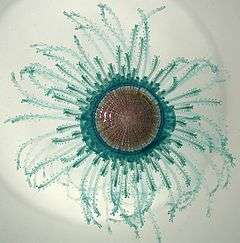Porpita porpita
| Porpita porpita | |
|---|---|
 | |
| Blue Button | |
| Scientific classification | |
| Kingdom: | Animalia |
| Subkingdom: | Eumetazoa |
| Phylum: | Cnidaria |
| Class: | Hydrozoa |
| Order: | Anthomedusae |
| Suborder: | Capitata |
| Family: | Porpitidae |
| Genus: | Porpita |
| Species: | P. porpita |
| Binomial name | |
| Porpita porpita (Linnaeus, 1758)[1] | |
_Blue_button%2C_found_on_Uttorda_Beach%2C_Goa%2C_India.jpg)
Porpita porpita, commonly known as the blue button, is a marine organism consisting of a colony of hydroids[2] found in tropical and sub-tropical waters of the Pacific,[3] Atlantic, and Indian oceans.[4] Although it is superficially similar to a jellyfish, each apparent individual is actually a colony of hydrozoan polyps. The blue button is a Chondrophore, which is a group of cnidarians that also includes Velella and Porpema. The chondrophores are similar to the better-known siphonophores, which includes the Portuguese Man o' War.
Characteristics
The blue button lives on the surface of the sea and consists of two main parts: the float and the hydroid colony. The hard golden-brown float is round, almost flat, and about one inch wide. The hydroid colony, which can range from bright blue turquoise to yellow, resembles tentacles like those of the jellyfish.[5] Each strand has numerous branchlets, each of which ends in knobs of stinging cells called nematocysts. The blue button sting is not powerful but may cause irritation to human skin.[2]
The blue button itself is a passive drifter, and is part of the neustonic food web. It is preyed on by the sea slug Glaucus atlanticus (sea swallow or blue glaucus) and violet sea-snails of the genus Janthina.[6] It competes with other drifters for food and mainly feeds on copepods and crustacean larvae.[7] The blue button has a single mouth located beneath the float, which is used for both the intake of prey and the expulsion of wastes.
See also
References
- ↑ WoRMS (2011). P. Schuchert, eds. "Porpita porpita (Linnaeus, 1758)". World Hydrozoa database. World Register of Marine Species. Retrieved 2011-12-18.
- 1 2 "Blue Buttons in Florida."
- ↑ Meinkoch, Norman. "The Audubon Field Guide to North American Seashore Creatures." 1981. New York, New York.
- ↑ see distribution at the Encyclopedia of Life
- ↑ "Identification Chart for Jellies."
- ↑ Hayward P.J. & Ryland J.S. (1990). The Marine Fauna of the British Isles and North-West Europe. Volume 2 - Molluscs to Chordates. page 681. Clarendon Press, Oxford. ISBN 0-19-857515-7
- ↑ Bieri, R. 1970. The food of Porpita and niche separation in three neuston coelenterates. Publications of the Seto Marine Biological Laboratory 17 (5): 305-307.
| Wikimedia Commons has media related to Porpita porpita. |